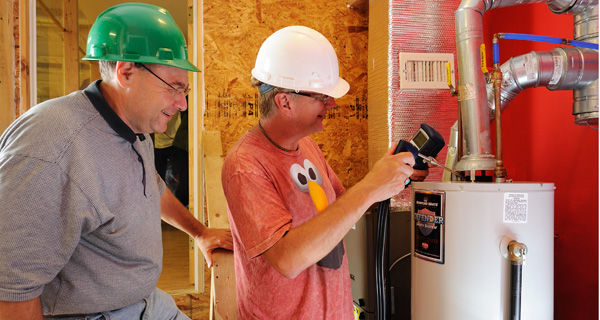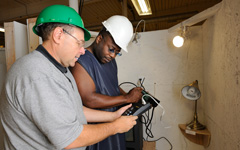story by
Liz Pacheco |
photos by
Albert Lee
Last March, Roger Lewis was laid off from his job at Hostess Brands. An electrician by trade, Lewis had worked in food industry manufacturing facilities for the past eight years. His recent job was as an industrial mechanic. “That’s basically making sure the building is running properly, all the electrical systems, plumbing and the machinery that produces the products,” explains Lewis. After a couple months looking for employment he saw an ad in the paper for free job training through a program with the Community College of Philadelphia and the Energy Coordinating Agency (ECA). “I figured I’d give it a try,” he says.
Lewis’ story is commonplace at the James L. Knight Green Jobs Training Center. Most students enroll in the training because they’ve lost their jobs. A class in July consisted mostly of out-of-work architects. Marco Ricca, now a lead instructor, had enrolled as a student at the center after working as a realtor and home remodeler. “I had 10 years experience working on not only my own properties, but properties of investors,” says Ricca. “I would help [investors] buy [a property], help them rehab it and help them sell it. I had the market cornered as long as there was a market.”
The training center is one of seven certified by the Department of Labor and Industry. Since it opened in March 2010, more than 2,000 men and women have been trained, with about 70 percent going directly into jobs. The center offers more than 17 certifications in skills like weatherization, building retrofits and energy audits—they were the first in Pennsylvania to be a Building Performance Institute (BPI) affiliate, a national standard for residential energy efficiency retrofit work. In February 2012, Philadelphia City Council named the facility a “Center of Excellence” for the success its education and training programs have had in creating opportunities for individuals in the sustainable job market.
“[The students] are getting marketable job skills,” says Ricca. “They’re also getting personal knowledge and personal enrichment on energy efficiency, how to save money on their home, things that they can do to improve the air quality and water quality in their own homes, as well as in their communities by getting jobs.”
Training Day Standing on the roof of the Energy Coordinating Agency’s training center, Miles Grosbard (green hard hat) instructs students from the Community College of Philadelphia on rooftop solar thermal heaters.
Building a Teaching Tool
From the street, the training center looks just like other old warehouses in North Philadelphia. But what once housed a Civil War uniform factory is now a LEED Gold certified facility. The building, redesigned by local sustainable design firm Re:Vision Architecture, has an insulated white roof, a rainwater harvesting system, solar thermal hot water heating, a solar photovoltaic system for on-site electricity, and low VOC materials, paints and wood finishes, among countless other energy efficient and environmentally-friendly elements. The close to $1.7 million in retrofits was funded mostly by the John S. and James L. Foundation with additional support from The Kresge Foundation.
The second floor boasts heating and insulation labs, life-sized mock-ups of rooms, even a small model home that allows students to see exactly how heat moves through an entire house. The curriculum reflects these hands-on teaching tools. Classes have two parts: a written portion and field work. “They have the ability to utilize any of our mock-ups and labs,” explains instructor Chris Robinson, a home performance contractor who has been in the field for eight years. “I like to balance—spend equal parts in the classroom and equal parts in the lab if possible.”
Robinson’s teaching methods go hand-in-hand with the center’s goals for learning. “It’s not just abstract theories or ‘death by PowerPoint,’” says Scott Coleman, Assistant Director, “but really hands-on, tactile learning that leads to some kind of retention and, hopefully, competency. So, getting people involved in group problem solving, getting them to use their hands instead of just sitting down.”
The most impressive “hands-on” teaching tool at the center is the walk-in model. A series of rooms represent a house with actual working appliances—stove, refrigerator, hot water heater, furnace and dryer. Students use the model to for a full diagnostic test. The walk-in model, says Walt Yakabosky, Director of Training, is the only one of its kind in the country.
Expanding on the Vision
When the center first opened in 2010, the economic crisis had made the demand for green job training greater. And, thanks to the 2009 American Recovery and Reinvestment Act (ARRA), the funding was there to support the programming. Although Pennsylvania was delayed in applying this money to new programs and curriculums, the state has since done exceptionally well in supporting green job training.
“The ECA has been around for almost 30 years,” says Yakabosky. “[But] I think the stimulus really put this industry on the map.” Aside from being the first to offer BPI certification in Pennsylvania, the center was also the first in the state to offer a federally-approved apprenticeship program for weatherization technicians and auditors. In this program, the Community College of Philadelphia (CCP) provides formal education and credit in the form of a certificate, and an employer provides the on-the-job training. CCP has developed an Associate Degree in Building Science with the training center as well. High school seniors even have opportunities to take courses and receive certifications thanks to a career pathways model created in partnership with the School District of Philadelphia.
The training center is also recruiting students by establishing relationships with local and regional organizations. “The way we were going to do [recruitment] is not by me, the old white guy, going into a community and convincing people what a great opportunity this is, because no one is going to pay any attention to me,” says Yakabosky. Instead, the center made partnerships with community-based organizations, such as the Federation of Neighborhood Centers – Philadelphia, Foundations Inc., Impact Services and the National Association of Minority Contractors.
Practice Field Students at the training center can utilize life-sized mock-ups of rooms to practice their new energy efficiency retrofit skills.
Keeping Ahead of the Curve
While the ARRA funding was important in launching the center, it limited training to focus on weatherization assistance programs. That funding for weatherization training ended on March 31, 2012, but with support from non-federal grants, the center has been able to market its extended curriculum—which has been in development since its opening—to those in other job fields.
“[Yakabosky] has designed the curriculum, the mock-ups, the training center in its entirety to be adaptable to any kind of audience that we would encounter, and able for us to put it in very workable terms for students, for trainees who come through the center,” says Coleman.
Yakabosky had conversations early on with the training center’s leadership in which they asked what certifications would be required to work with utility companies and contractors. Then, the city won the grant that created EnergyWorks. “We were managing [EnergyWorks] and started to put curriculum together to have these contractors certified in whatever discipline they needed to become part of the whole process,” he says.
Certifications are a driving element of curriculum development. “We do our best to stay ahead of the curve in terms of where we see all these certification requirements are headed,” says Dan Casper, who does curriculum development and project management. “We always try to be one of the first people to offer these certifications.”
Keeping ahead of certifications also means that training center students are better prepared and more desirable in the job market. “A lot of money that’s funded into the green economy is from government agencies, and is stipulated for the workers to hold credentials,” explains David Dennis, an instructor and curriculum designer. “The credentials that we offer here—the certifications—follow those trends. As the credentials change, a lot of times our training changes [as well].”
One example is the new curriculum Ricca, Casper and Dennis created for the Philadelphia Water Department on stormwater management practices for residents. Previously, stormwater management was something handled on construction sites, and the practices weren’t adaptable for residential use. The team of instructors has scaled down the practices and created a curriculum from scratch.
“We have a lot of experience in a lot of different fields, primarily energy, but we’ve really headed in the stormwater direction,” says Casper. “That’s not something that we did very much, and then there was an opportunity. We sought experts who had the expertise and we developed the expertise in-house.” This flexibility to adapt to changing technologies and needs is what has made the center so successful. Students are learning cutting-edge skills that lead to jobs as well as healthier homes and neighborhoods.
And that’s exactly what students like Roger Lewis are counting on.
“This is the wave of the future. Everything is going green,” says Lewis. “In order to adapt to the job climate you got to pick up new skills. Five, 10 years from now, BPI certification is probably going to be a major thing, so it’s good to get a head start on it.





